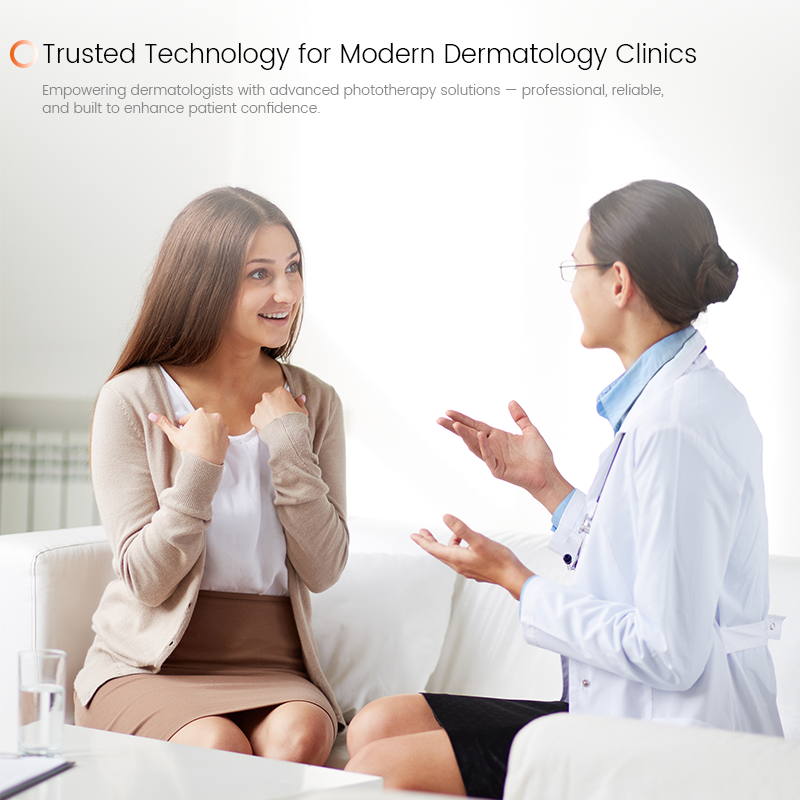
In today’s rapidly evolving dermatology landscape, both patients and clinicians are seeking treatments that are not only effective but also convenient and adaptable for use in clinics and at home. The new desktop UVB phototherapy system from Diosole stands out as an innovation that combines medical-grade performance with a compact and accessible design, offering reliable support for patients suffering from vitiligo and psoriasis.
A device designed for practicality and performance
The UVB phototherapy device features a Philips special UV lamp that ensures stable, long-lasting operation. Its structure is compact and lightweight, designed for easy operation and efficient energy use. Inside the treatment head, a reflective panel improves radiant efficiency, ensuring that each treatment session delivers consistent and targeted UVB exposure.
These design details reveal the manufacturer’s clear focus on usability and precision. For dermatology clinics, the device’s small footprint allows for flexible installation, even in limited spaces. For patients under medical supervision, its simplicity allows for consistent therapy without the need for hospital-sized equipment.
Why UVB phototherapy matters
UVB phototherapy is a proven and trusted approach for treating a range of chronic skin conditions, most notably psoriasis and vitiligo. In psoriasis, UVB light slows down the abnormal growth of skin cells and reduces inflammation. In vitiligo, UVB exposure can stimulate melanocyte activity, encouraging repigmentation in affected areas.
Both conditions are long-term and require regular therapy to maintain improvement. A portable UVB device helps make that possible, reducing the need for frequent clinic visits and making the treatment process more convenient and sustainable for patients.
Targeted for vitiligo and psoriasis
Psoriasis and vitiligo, while distinct in cause and appearance, both respond effectively to controlled UVB treatment.
In psoriasis, UVB reduces the excessive turnover of keratinocytes and calms local inflammation.
In vitiligo, UVB encourages pigment cell regeneration and balances immune reactions that disrupt melanin production.
By bringing these mechanisms together in a compact format, the Diosole desktop UVB device makes phototherapy more accessible to both healthcare providers and patients. Its intended use, under a doctor’s guidance, ensures safety while maximizing clinical benefit.
A bridge between clinic and home
Traditional phototherapy often requires large, full-body cabinets and frequent visits to specialized centers. This is time-consuming and can discourage adherence, especially for patients with busy schedules or limited access to dermatology facilities. A desktop phototherapy unit, on the other hand, offers a hybrid model—clinic-level efficacy in a smaller, more flexible format.
For small dermatology practices, it adds treatment capacity without heavy equipment investment. For patients, it allows supervised at-home use, improving convenience and continuity of care. This approach aligns with the growing global trend toward personalized, home-based medical technology.
Safety and responsible use
Although UVB therapy is safe when used correctly, precise dosing and proper protection are critical. Patients should use the device under physician supervision, follow prescribed exposure times, and protect unaffected skin and eyes during treatment.
The Diosole device’s use of a stable UV source and internal reflection board ensures even exposure, minimizing the risk of uneven dosing. Regular monitoring and adherence to guidelines remain essential for optimal results.
Expanding accessibility and outcomes
Compact UVB phototherapy units like this one could change the way chronic skin diseases are managed. They make treatment more accessible to remote or smaller clinics and reduce costs associated with large phototherapy chambers. For patients, the option to undergo treatment in the comfort of their own space, with appropriate medical oversight, significantly enhances compliance and long-term outcomes.